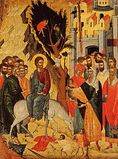

| Previous day | Next day |
| Old Style
April 8
|
Sunday |
New Style
April 21
|
|
The Entry of the Lord into Jerusalem— Palm Sunday.
Great Lent. Fish, wine and oil allowed. |
Fish, wine and oil allowed.
|
![]() Holy Apostles of the Seventy: Herodion, Agabus, Asyncritus, Rufus, Phlegon, Hermes, and those who suffered with them (1st c.).
Holy Apostles of the Seventy: Herodion, Agabus, Asyncritus, Rufus, Phlegon, Hermes, and those who suffered with them (1st c.).
Martyr Pausilipus of Thrace (ca. 117-138). St. Celestine, pope of Rome (432). St. Niphont, bishop of Novgorod (1156). St. Rufus the Recluse, of the Kiev Caves (14th c.).
New Hieromartyr Sergius Rodakovsky, archpriest, of Tal (Belorussia) (1933).
Spanish Icon of the Most Holy Theotokos (792).
Monk-martyrs Josiah and Joseph, of Mt. Kharasam, Persia (ca. 341). St. Philaret of Seminara, Calabria (ca. 1070). New Martyr John (Koulikas) (1564). New Martyr John Naukliros (“the Navigator”), on Kos (1699).
Repose of Helen Voronova, disciple of Elder Barsanuphius of Optina (1916).
Thoughts for Each Day of the Year
According to the Daily Church Readings from the Word of God
By St. Theophan the Recluse

Palm Sunday. [Phil. 4:4–9; John 12:1–18]
Who did not meet the Lord when He, as a king, triumphantly entered into Jerusalem; and who did not cry out then, Hosanna to the Son of David! (Matt. 21:15)? But only four days passed, and the same crowd with the same tongues cried, Crucify Him, crucify Him! (John 19:6). An amazing change! But why should we be surprised? Do we not do the very same thing, when upon receiving the holy Mysteries of the Body and Blood of the Lord, we barely leave the church before forgetting everything—both our reverence and God’s mercy toward us. We give ourselves over as before to self-pleasing deeds—at first small and then also large. Perhaps even before four days have passed, although we do not cry, “Crucify Him!” we will crucify the Lord within ourselves. The Lord sees all of this, and suffers. Glory to Thy longsuffering, O Lord!
Articles
 Apostle Rodion of the SeventySaint Rodion, or Herodion (April 8), was a kinsman of the Apostle Paul (Romans 16:11), and left the bishop’s throne at Patras to go to Rome with the Apostle Peter. |
 Apostle Hermas of the SeventyThe Holy Apostle Hermas was a bishop in Philippopolis, Thrace. |
 Martyr Pausilippus of Heraclea in ThraceThe Holy Martyr Pausilippus suffered under the emperor Hadrian (117-138). |
 St. Celestine the Pope of RomeSaint Celestine, Pope of Rome, a zealous champion of Orthodoxy, lived during the reign of the holy Emperor Theodosius the Younger. |
 Venerable Rufus the Obedient of the Kiev Far CavesSaint Rufus the Obedient, Hermit of the Caves, lived at the Kiev Caves monastery during the fourteenth century. |


